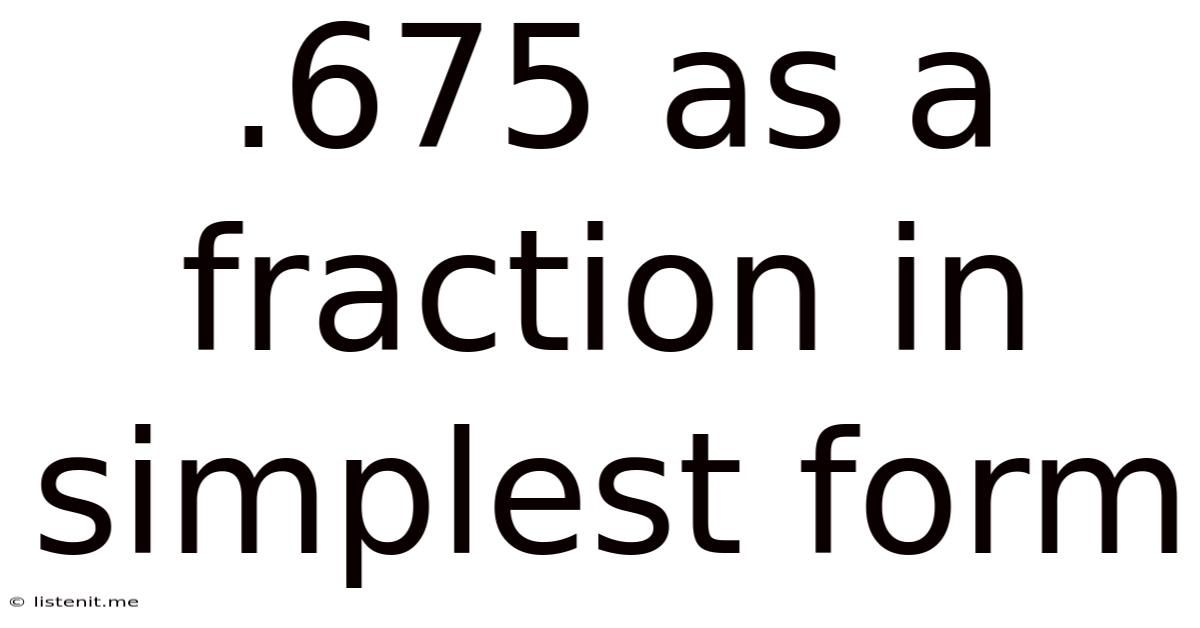.675 As A Fraction In Simplest Form
listenit
May 12, 2025 · 4 min read

Table of Contents
.675 as a Fraction in Simplest Form: A Comprehensive Guide
Converting decimals to fractions might seem daunting at first, but with a systematic approach, it becomes a straightforward process. This comprehensive guide will walk you through converting the decimal 0.675 into its simplest fraction form, explaining each step in detail and providing additional tips and tricks for similar conversions. Understanding this process will not only help you solve this specific problem but will also equip you with the skills to tackle other decimal-to-fraction conversions with confidence.
Understanding Decimals and Fractions
Before diving into the conversion, let's quickly refresh our understanding of decimals and fractions.
Decimals: Decimals represent a part of a whole number using a base-ten system. The digits to the right of the decimal point represent tenths, hundredths, thousandths, and so on. For example, 0.675 represents 6 tenths, 7 hundredths, and 5 thousandths.
Fractions: Fractions represent a part of a whole number as a ratio of two integers – a numerator (top number) and a denominator (bottom number). The denominator indicates the total number of equal parts the whole is divided into, and the numerator indicates how many of those parts are being considered. For example, 1/2 represents one part out of two equal parts.
Converting 0.675 to a Fraction: Step-by-Step
The key to converting a decimal to a fraction lies in understanding the place value of the last digit. In 0.675, the last digit, 5, is in the thousandths place. This means our denominator will be 1000.
Step 1: Write the decimal as a fraction with a denominator of 1000.
This is the initial step in converting our decimal. Since the last digit is in the thousandths place, we can write 0.675 as the fraction:
675/1000
Step 2: Simplify the fraction by finding the greatest common divisor (GCD).
The fraction 675/1000 is not in its simplest form. To simplify, we need to find the greatest common divisor (GCD) of both the numerator (675) and the denominator (1000). The GCD is the largest number that divides both the numerator and the denominator without leaving a remainder.
Finding the GCD can be done using several methods:
- Prime factorization: This involves breaking down both numbers into their prime factors and identifying the common factors.
- Euclidean algorithm: This is a more efficient method for larger numbers. It involves repeatedly dividing the larger number by the smaller number until the remainder is 0. The last non-zero remainder is the GCD.
Let's use prime factorization for 675 and 1000:
- 675: 3 x 3 x 3 x 5 x 5 = 3³ x 5²
- 1000: 2 x 2 x 2 x 5 x 5 x 5 = 2³ x 5³
The common factors are 5 x 5 = 25. Therefore, the GCD of 675 and 1000 is 25.
Step 3: Divide both the numerator and the denominator by the GCD.
Now that we have the GCD, we divide both the numerator and the denominator of our fraction by 25:
675 ÷ 25 = 27 1000 ÷ 25 = 40
This gives us the simplified fraction:
27/40
Therefore, 0.675 expressed as a fraction in its simplest form is 27/40.
Alternative Methods and Considerations
While the prime factorization method is effective, the Euclidean algorithm offers a more efficient approach for larger numbers. Let's illustrate this with our example:
Euclidean Algorithm:
- Divide 1000 by 675: 1000 = 1 x 675 + 325
- Divide 675 by 325: 675 = 2 x 325 + 25
- Divide 325 by 25: 325 = 13 x 25 + 0
The last non-zero remainder is 25, which is our GCD. This confirms our previous finding.
Practical Applications and Further Exploration
Understanding decimal-to-fraction conversions is crucial in various fields, including:
- Mathematics: Solving equations, simplifying expressions, and performing calculations involving both fractions and decimals.
- Science: Measurements and data analysis often involve converting between decimals and fractions.
- Engineering: Precise measurements and calculations frequently require working with fractions.
- Cooking and Baking: Recipes often use fractions, and understanding conversions can be helpful in adjusting ingredient quantities.
Expanding Your Knowledge: Converting Other Decimals
The process outlined above can be applied to any decimal. However, the complexity of finding the GCD might increase with larger numbers. Remember these key steps:
- Identify the place value of the last digit: This determines the denominator.
- Write the decimal as a fraction: The digits to the right of the decimal point become the numerator, and the place value becomes the denominator.
- Simplify the fraction: Find the GCD of the numerator and denominator and divide both by the GCD.
Examples:
- 0.75: 75/100 = 3/4 (GCD = 25)
- 0.125: 125/1000 = 1/8 (GCD = 125)
- 0.375: 375/1000 = 3/8 (GCD = 125)
This comprehensive guide provides a solid foundation for understanding and performing decimal-to-fraction conversions. Remember that practice is key to mastering this skill. By consistently applying these steps, you’ll become proficient in converting decimals to their simplest fraction forms, enhancing your mathematical abilities and problem-solving skills in various contexts. The ability to confidently manipulate fractions and decimals is a valuable asset across numerous academic and professional disciplines.
Latest Posts
Latest Posts
-
Mass Of One Atom Of Carbon 12
May 12, 2025
-
How To Find Ions In A Compound
May 12, 2025
-
Every Equilateral Triangle Is An Isosceles Triangle
May 12, 2025
-
Speed Is Scalar Or Vector Quantity
May 12, 2025
-
Sound Travels Faster In Which Medium
May 12, 2025
Related Post
Thank you for visiting our website which covers about .675 As A Fraction In Simplest Form . We hope the information provided has been useful to you. Feel free to contact us if you have any questions or need further assistance. See you next time and don't miss to bookmark.